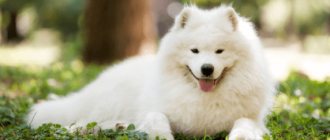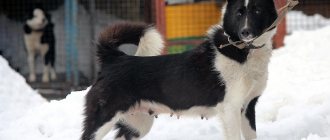History of the breed
The Nova Scotia Retriever is a breed with outstanding working abilities.
The Nova Scotia Retriever breed has a second name - Toller. We first learned about it from historical reference books of the 17th century. A dog of this breed was brought from Europe to Canada. English spaniels are considered relatives of retrievers.
The Nova Scotia Duck Retriever has become popular due to its ability to attract and catch waterfowl. They can jump after ducks even into icy water. Their coat is considered waterproof.
Toller is an excellent duck hunter
Origin story
As a breed, the Nova Scotia Retriever developed in the early 19th century in the Little River Harbor Community of Yarmouth, Nova Scotia, Canada. It was originally known locally as the Little River Duck Dog or Yarmouth Toller.
The author of works on the history of Canadian dogs dating back to the 18th century, Nicholas Denis, does not deny that small red retrievers could have been brought from the Old World to the Eastern Province of Canada. But it is also likely that the breed developed here in Nova Scotia from several other European breeds. The toller's ancestors could have been Bretons, golden retrievers, spaniels, Irish setters and herding dogs of the border collie type.
In the 17th to 19th centuries, red duck dogs were widespread on the East Coast of Canada. The breed was officially recognized by the Canadian Kennel Club in 1945. The Fédération Cynologique Internationale (FCI) recognized the breed in 1987.
Hunting with a Nova Scotia Retriever calling in ducks
Already by the name, it becomes clear that these dogs can not only bring wounded animals from land or water, but are also capable of luring ducks, which is undoubtedly a unique talent.
The Nova Scotia Retriever works on the same principle as the red fox. He runs along the shore and actively waves his tail. Ducks flock to these movements as if spellbound. On paper this style of hunting seems absurd, but in life it really works.
The hunter hides not far from the shore and throws a stick or ball to the dog. She runs along the pond in search of a toy and creates a fuss. At this time, attracted by the noise and movement of the fluffy red tail, the ducks swim towards the shore as if hypnotized. After a series of successful shots from the hidden hunter, the toller, as befits a true retriever, retrieves the bird from the water. It is worth noting that these dogs adore water, swim very well, can dive, and are ready to work day and night, at any time of the year, until the water is covered with ice. The webbed paws facilitate rapid movement in the water, and the dense undercoat protects against hypothermia.
In most countries of the world, Tollers are used exclusively as retrievers, but among hunters there are true connoisseurs of the breed who, with the help of a dog, lure birds.
Video about the dog breed Nova Scotia Retriever (Toller):
Description of the breed
Externally, Nova Scotia retrievers can be compared to foxes; they also have common behavioral traits; they are excellent hunters.
Tollers use a unique hunting method. They lure ducks with loud noise and splashing near the shore, and as soon as the bird swims up, the hunter kills it, and the dog drags it ashore.
For reference! In normal life, outside of hunting, the retriever requires moderate activity. About two hours of physical activity a day is enough for him.
Raising and training a pet
Tollers have established themselves as a breed of obedient and quickly trained dogs. But, like other dog breeds, Tollers sometimes cause difficulties for their owners.
Toller training should begin in puppyhood.
In order for your dog to master basic commands in a timely manner, training must begin at 2 months of age. First of all, the dog is accustomed to the daily routine, the rules of behavior in the house are explained, and the dog is taught its nickname and the first simple commands. This will help make walking outside safer. Then they move on to more complex tasks.
Important! The main rule of raising a retriever is to diversify the training, turning it into a game.
If your dog is disobedient, do not raise your voice or use brute force. As a punishment, deprivation of a toy or treat, feigned sensitivity, is suitable.
General information and breed standards
Nova Scotia Retrievers are medium-sized dogs. Their height does not exceed 50 cm, and their maximum weight reaches 25 kg. The main breed standards include:
- muscular build;
- wedge-shaped head, wide skull, which makes the retriever look like a Labrador;
- The coat color varies from red to orange, you can find representatives of the breed with white spots;
- Triangular ears with a high set.
Important! The main feature of the breed is its waterproof, medium-length double coat with a dense undercoat.
Nova Scotia Retrievers have a small but powerful build.
Advantages and disadvantages
Toller is a dog that has its pros and cons. This is a very smart and quick-witted breed. They are devoted to their owners and are always ready to actively protect them. Retrievers are excellent hunters and, thanks to their unique double coat, can withstand low temperatures.
The disadvantages of the breed include:
- Tollers absolutely cannot stand loneliness;
- severe shedding, requiring regular brushing;
- the need for long walks and physical activity.
Important ! You only need to walk your Canadian Retriever on a leash, as the pet gets carried away very quickly and can run away.
Toller is a loyal and devoted friend with an affectionate character
Education and training
It is important to start working with a toller from an early age; comprehensive socialization is important. It is quite easy to train, and if you add to this the desire to please the owner, then in the right hands he will become an ideal working dog.
A Toller cannot be worked as a service dog. He quickly remembers commands, but does not like to repeat the same thing and lacks perseverance. Much greater results can be achieved if the classes are as varied as possible. Under no circumstances should you put pressure on the dog, otherwise it becomes withdrawn and will not make contact in the future.
Toller seeks support and praise. This, provided there is close contact with the owner, will be the key to success in education and training.
Color variations and appearance
Tollers are small in size, but have a powerful and muscular build.
- Dimensions. Males reach up to 51 cm in height and weigh on average 22 kg; females weigh 20 kg and grow up to 48 cm.
- Wool. The main feature of the duck breed is its thick double coat, thanks to which the dog can even jump into icy water. The downside is heavy shedding. Therefore, the retriever is not suitable for those who want a neat and clean dog.
- The color of the dog can take on various shades from brown to orange.
Care and maintenance
The Scottish Retriever requires special care, which includes hygiene procedures, regular veterinary examinations, vaccinations and physical activity.
Combing
The main difficulty in caring for Nova Scotia Retrievers is the need to comb their thick coat. During the molting period, the procedure should be carried out at least twice a week.
Bathing
You should not wash your pet too often. This should be done as needed. It is not recommended to use shampoos. If the coat is too dirty, you can use plain, unscented soap.
Retrievers should be bathed no more than once every three weeks.
Walk
The Canadian Retriever needs long walks every day.
Additionally, it is recommended that once a week you take your pet to a field or other spacious place where he can run actively. Dogs kept in apartment conditions are especially in dire need of additional walking.
Ears
Ears should be examined daily and wax accumulation should be removed with cotton swabs.
Claws
As they grow, you need to trim the claws with a special nail clipper. In retrievers they grow back very quickly.
Teeth
Plaque is removed as needed with special brushes that are placed on the fingers.
Eyes
Cotton pads soaked in a special solution are used to wipe the eyes and remove natural secretions.
Training and education
Retrievers are highly trainable, but you need to be patient during the process as the dog is often stubborn.
Important! Experienced breeders recommend combining learning commands with play, so the pet will better perceive them.
Physical exercise
The Nova Scotia Duck Retriever is a working dog that needs constant exercise. Without them, she will become apathetic. You need to take your pet for a walk every day and give it the opportunity to run. Hunting instincts can be satisfied with games.
Tollers need daily exercise that will help replace hunting
Is it possible to keep in an apartment?
The optimal housing for retrievers is a private home. The dog should have enough space for active movement. Tollers can also live in an apartment, but in this case they need to be walked for a long time every day.
Character and behavior
The Nova Scotia Retriever is a surprisingly multifaceted personality. He is a talented retriever, agile, fast and obedient enough for agility, frisbee and other sports, patient and easy to train for obedience competitions. He is purposeful in his work, energetic, cheerful. Loves to be the center of attention. Ready to do anything to please the owner. The standard says that the toller's eyes light up when he works and this is true. He has one more feature. Nova Scotia Retrievers sometimes “scream” when they are happy or excited. This sound is difficult to convey in words, something between a squeak, howl and growl. The toller has friendly relations with all family members. He gets along well with children of any age, tries to be careful and caring with kids, and shows patience and sensitivity. Of all, the toller usually singles out one; he strives to be a dog of one owner.
Thalers are often confused with golden retrievers, but these breeds are both physically and psychologically different.
The territorial instinct is weakly expressed. The dog will not protect the owner, much less his property, but will bark at passersby and extraneous noises. He treats strangers with caution, he treats the owner’s friends and acquaintances in a friendly manner, but not as friendly with them as a Labrador or a Golden Retriever.
The Nova Scotia Retriever is suitable for a variety of sports. Most often dogs are trained in obedience and agility. Tollers for search tasks are very good, which are an excellent way to develop the innate talents of a retriever.
They get along well with other pets, but being a hunter to the core, they can be too persistent in games, which cats and calmer dogs do not always like.
Life expectancy and major diseases
An Irish Retriever, if well cared for, lives on average from 12 to 15 years. This is a strong and hardy dog that rarely gets sick and adapts well to different climatic conditions. Canadian veterinarians have compiled a list of all the diseases to which the toller is most susceptible. These include:
- hip dysplasia;
- intervertebral disc diseases;
- deafness;
- diabetes;
- progressive retinal abnormality.
Important! Most often, all these diseases are hereditary.
Vaccinations
Retrievers need regular vaccinations, preventive examinations and treatment for all types of parasites. The first vaccination is carried out for the puppy in the nursery at the age of two months. It is imperative to be vaccinated against rabies, parainfluenza, hepatitis, and distemper.
Nutritional Features
Toller is a dog that needs a combined diet. It should contain not only dry food, but also natural food. Nova Scotia Retrievers are not picky eaters and are not prone to allergic reactions. Your pet's daily diet should include:
- vegetables fruits;
- rice and buckwheat porridge;
- dairy products;
- lean boiled meat;
- sea fish without bones.
Representatives of these breeds should not be given chicken, pork, sweets, or baked goods made from premium flour.
Important! Overeating should not be allowed. This can lead to the development of obesity.
Nova Scotia Retrievers must receive a comprehensive diet.
How to choose a puppy
When choosing a puppy, it is recommended to pay attention to the following points:
- It is best to buy from a trusted nursery, where all documents will be provided;
- check the conditions of detention;
- observe the puppy for at least 15 minutes, he should be active and playful;
- carefully check the condition of the eyes and ears; there should be no foreign secretions in them;
- The fur should be evenly distributed over the entire body, the tail should not be kinked.
It is also recommended to consult with experienced dog breeders before purchasing.
How much does it cost to own a dog?
Care and maintenance of a retriever does not require large expenses. Expenses may only be required for grooming and providing the pet with proper nutrition enriched with vitamins.
The cost of haircuts and nail trimming depends on the region and the level of the salon. On average, the procedure will cost 800-1000 rubles.
Choosing a Nova Scotia Retriever puppy
In Russia and the CIS countries, the number of Nova Scotia retrievers is growing every year. In total there are already more than 300 dogs. An application has been submitted to create a National Breed Club in Russia, which will allow uniting owners and regulating breeding activities. Several kennels have appeared, dogs continue to be bred by individual owners, so it is becoming increasingly easier to buy a puppy. Another thing is that the toller does not always meet the requirements and have the necessary working qualities. When choosing a puppy, it is important to ensure the responsibility of the breeder and the quality of the parents. A huge plus will be the availability of tests for major diseases that are common in the breed.
It is better to buy a puppy abroad through the National Breed Club. On the websites of such organizations, only advertisements for the sale of purebred puppies that are the result of planned matings are posted. There are plenty of scammers in all countries.
Little Toller puppies are round and soft in every way. Their ears seem disproportionately large to the head, their eyes are expressive, the color of the nose, eyelids, lips and eyes must correspond to the standard. The paws are strong, straight, and because of the soft fluffy fur they appear a little more rounded. The baby should be moderately well-fed, absolutely healthy in appearance, energetic, curious, with an attentive, friendly expression characteristic of the breed.
Abroad, the average price of a Nova Scotia retriever puppy is $800. The cost is influenced by the age of the baby, the working qualities of the parents, their titles, the level of the nursery and much more. In Russia and the CIS countries, breeder owners try to maintain the same price range; on average, puppies are sold for 40,000-45,000 rubles.











